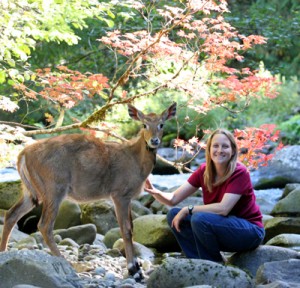We got a call for a project that needed an antelope lifting his head suddenly on cue. Easy enough… 
But they had previously hired another company who had failed because getting to the studio required riding in an elevator and the antelope would not get on the elevator. According to the producer who called us, they had tried to push and pull their antelope onto the elevator, and he had bucked, kicked, flailed, and generally had a frightening fit! The producer was understandably very concerned that the same thing not happen again because they had wasted a LOT of money that day having the entire crew waiting…
I said, “No worries, we need a week to train.” He argued that it was a really easy scene, and I explained that the week was to train him to enjoy the elevator, and that I would not take the job with less.
I got the job, and for the next five days we took our antelope to town to play on elevators. For the entire first day we never asked him to get on an elevator, but he got treats and praise for approaching the elevator and had a great time, and we practiced walking him over a piece of carpeting in a doorway. We moved his feet all over and around the elevator entrance and released pressure whenever he got near to the elevator. The second day he learned to trot into the elevator over the same piece of carpet and right back out. The third day the door closed and then opened right away, etc… By the end of the week he was leading perfectly onto several different elevators and happily riding up and down, and a lot of people thought we were crazy…
We went to the soundstage the next week, where we met with the producer and went up to the studio. Of course, Gamble led onto the elevator and rode perfectly and walked into the studio and nailed the shot. The man smirked at me and said, “I can’t believe you charged me for a week of training when obviously your antelope has no problem riding the elevator.”
I tried and tried to explain to him that IF I had shown up the week before and attempted to force Gamble onto the elevator he would have behaved exactly as the other animal did, but no amount of arguing would convince him. I had taken some video of the prep, so I could have shown him the hours of work, but at no point during the prep did we try to force Gamble, so there was never a confrontation, never a moment that looked like there was a problem, never a moment in which Gamble was not having a good time. Because, as in most animal training, the best path to success was for me to be smart enough to manipulate the situation so that Gamble was able to succeed without ever really knowing that there was even an issue.
If we do our jobs well as animal trainers, it creates the absolutely untrue illusion that we are doing nothing–animal trainers generally only look like heroes when they have allowed something to fail and then appear to be saving the day…

Thank you for that information. I just became the proud owner of a Saint Bernard who refuses to use the elevator, so we’ve been taking the stairs. I will be trying this approach.